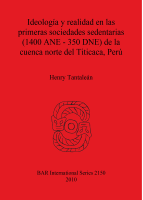Description
BOOK DESCRIPTIONThis study explains the social development of archaeological settlements and artefacts related to the first sedentary societies (1400 BC- AD 350) of the Northern Titicaca Basin, Peru. Such societies passed through a very wide event horizon, but a major influence was the qualitative and quantitative changes in the way these archaeological settlements and objects evolved. This deep change in historical trajectory is related to the existence of a society that produced an unusual complex of buildings and artifacts that are distinguished from others of the Andean area and known under the name of Pukara (400 BC-AD 350). The research is divided into five chapters. Chapter 1 analyzes recent archaeological discourses focused on an objective knowledge of social reality, recognizing the impact of ideologies on the interpretations of archaeologists. Chapter 2 looks at the relationship between dominant ideologies and archaeologies in Peru in the 20th century in Peru. Chapter 3 explores the archaeological discourses on the North Titicaca Basin and it relationship with different ideologies. Chapter 4 is focused on the archaeological settlements and objects of the first sedentary societies of the North Titicaca Basin which help define more appropriate archaeological representations through an objective knowledge of the prehistoric reality. The chapter helps explain the archaeological settlements and objects known from the researches conducted in the 20th century so as to allow an overview of the archaeological objects within contexts of production and use. Chapter 5 describes the author's programme of archaeological researches into the settlements and artefacts of the first sedentary societies (1400 BC - AD 350) in the area of study (Quilcamayo-Tintiri valley, Puno).











